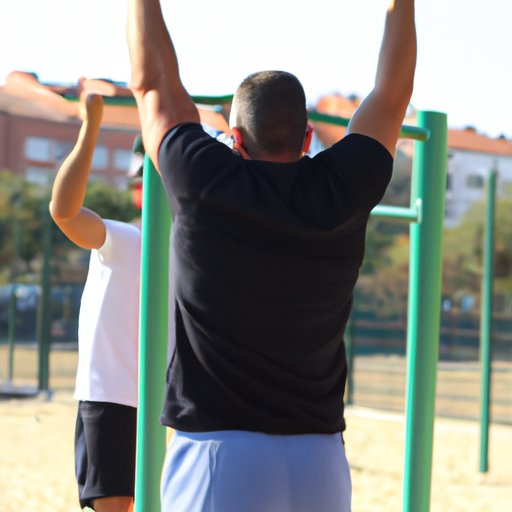
I. Introduction
There’s often confusion between physical activity and exercise, with many using the terms interchangeably. However, understanding the difference between the two is crucial to maintaining an active lifestyle and achieving fitness goals. In this article, we’ll provide a comprehensive guide to distinguishing between physical activity and exercise.
II. Physical Activity vs. Exercise: Understanding the Key Differences
Physical activity refers to any movement that involves the body’s muscles, resulting in an increased level of energy being expended. This can include walking, gardening, playing sports, and housework. Exercise, on the other hand, is planned, structured, and repetitive physical activity aimed at improving fitness levels. Examples include strength training, aerobics, and running.
The key difference between the two is that exercise is more structured and planned, and it is aimed at improving fitness levels. Physical activity, while often beneficial, is not necessarily structured and may not be as focused on improving fitness levels.
III. Breaking it Down: The Difference Between Physical Activity and Exercise
It can be a challenge to distinguish between physical activity and exercise, as many activities can overlap. However, when it comes to exercise, there are five key elements that define it:
- Planned: Exercise is often planned in advance and forms part of a regular routine.
- Structured: Exercise typically follows a structured format, with a clear beginning, middle, and end.
- Repetitive: Exercise is often repetitive and involves similar movements being performed repeatedly.
- Intentional: Exercise is done with the intention of improving fitness levels.
- Goal-oriented: Exercise is usually done with specific goals in mind than in pursuit of fitness.
Physical activity, on the other hand, may have some of these characteristics, but it does not necessarily have all five. It is less structured, less repetitive, and may not be intentional.
IV. Fitness 101: Defining Physical Activity and Exercise
Physical activity and exercise can both contribute to improved fitness levels and overall health. Regular physical activity has been linked with the prevention of diseases, including obesity, heart disease, and diabetes. In contrast, exercise has a more focused effect on the improvement of physical fitness, including strength, endurance, and flexibility.
There are many different types of physical activity and exercise. Physical activity can include activities such as brisk walking, dancing, gardening, household tasks, and leisure activities. Exercise can include strength training, high-intensity interval training (HIIT), aerobics, running, and yoga.
V. How to Determine Whether You’re Active or Exercising: A Comprehensive Guide
It can be tricky to determine whether an activity is physical activity or exercise. However, there are a few things to keep in mind that can help you establish this:
- Intensity: Exercise is often more intense than physical activity and can be measured in terms of heart rate, effort level and calories burned.
- Duration: Exercise typically lasts longer than physical activity and is done with greater intention.
- Structure: Exercise is structured, meaning it follows a particular format. In contrast, physical activity may be more “spontaneous.”
- Goals: Exercise is done with specific goals in mind, such as improving strength or endurance
It’s also important to set and track fitness goals regularly. This can be done by keeping a fitness journal, using an app, or hiring a personal trainer. Tracking progress can help you recognize the difference between physical activity and exercise.
VI. The Fine Line Between Physical Activity and Exercise: Why It Matters
While both physical activity and exercise are beneficial, confusing the two can have negative effects on your health and fitness goals. If you’re confusing physical activity with exercise, you may not be getting the right amount or type of activity needed to improve fitness levels. This can impact overall health and well-being, potentially leading to a range of health complications.
Understanding the distinction between physical activity and exercise is also important when setting fitness goals and planning workouts. Knowing your goals can help you structure your activities accordingly and improve your chances of success.
VII. Maximizing Your Health: Learning the Distinction Between Physical Activity and Exercise
Maximizing your health requires incorporating both physical activity and exercise into your routine. A balanced exercise program may include strength training, cardio, and flexibility exercises. Physical activity can also include leisure activities such as sports, dancing, or hiking. Choosing activities that you enjoy can make it easier to stick to a program and make it a part of your lifestyle.
Here are some tips on how to create a balanced workout routine:
- Set clear fitness goals.
- Choose activities that you enjoy and fit into your routine.
- Mix up your routine to keep it interesting.
- Track your progress to stay motivated.
- Listen to your body and adjust your routine accordingly.
VIII. Conclusion
In conclusion, understanding the difference between physical activity and exercise is important for achieving fitness goals and overall health. While they share similar benefits, they differ in terms of structure, intention, and intensity. By incorporating both physical activity and exercise into your routine, you can maximize your health and well-being.
It’s essential to set clear goals, track your progress, and listen to your body to maintain a balanced routine. Remember, staying active and moving every day is vital for overall health, no matter whether you are engaging in physical activity or exercise.





